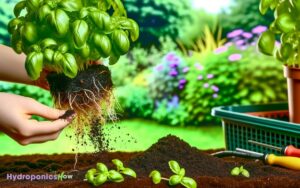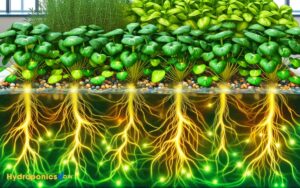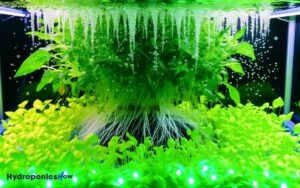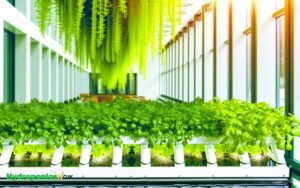What Do Hydroponic Plants Need: A Complete Guide!
Hydroponic plants need a carefully calibrated nutrient solution with essential macro and micronutrients such as nitrogen, phosphorus, potassium, iron, and zinc to guarantee proper growth. Ideal pH levels between 5.5 to 6.5 are critical for nutrient uptake, while consistent lighting, particularly within the blue and red spectra, supports photosynthesis.
Adequate oxygenation, through air stones or pumps, is necessary to avoid hypoxia in the root zone. Temperature control, both in the root and air zones, optimizes enzymatic activities and nutrient absorption.
Maintaining high water quality and providing robust support structures further guarantees plant stability and productivity, paving the way for vigorous growth.
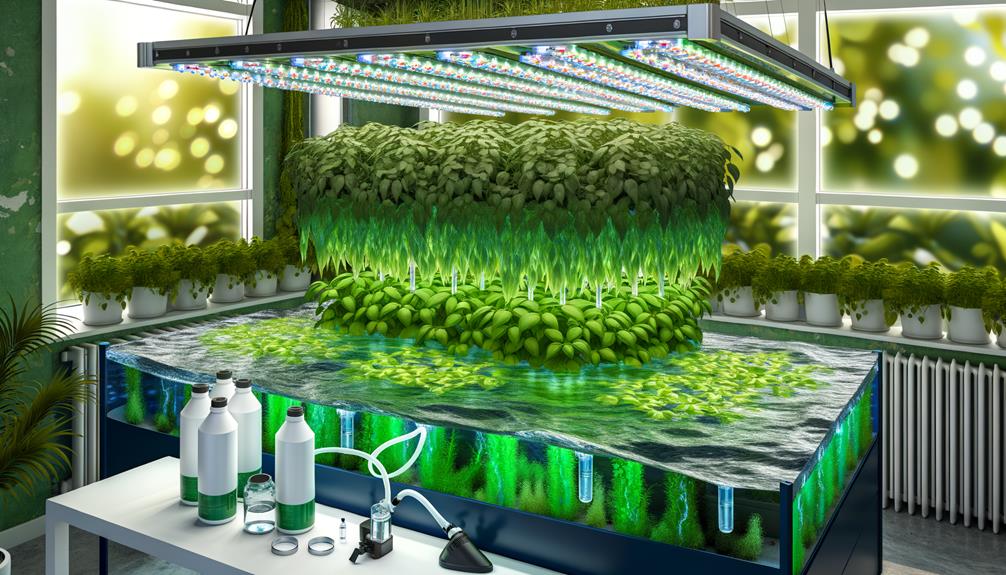
Key Takeaways
- Hydroponic plants need a precise nutrient solution with essential macro and micronutrients.
- Maintaining a pH range of 5.5 to 6.5 is crucial for nutrient uptake.
- Adequate lighting with the correct spectrum is essential for photosynthesis and growth.
- Sufficient oxygen supply to the roots is necessary to prevent hypoxia and root rot.
What Hydroponic Plants Need: Essential Elements for Successful Growth
| Essential Requirement | Description | Importance for Plant Growth |
|---|---|---|
| Water | Clean, oxygen-rich water used as the growth medium. | Hydration and nutrient delivery. |
| Nutrients | Essential minerals dissolved in water (Nitrogen, Phosphorus, Potassium, etc.). | Vital for healthy plant growth and development. |
| Oxygen | Oxygen provided to the roots through aeration or misting. | Supports root respiration and health. |
| Light | Adequate light, usually from grow lights (e.g., LED or fluorescent). | Required for photosynthesis and energy production. |
| pH Level | Optimal pH range (usually between 5.5 and 6.5). | Ensures efficient nutrient uptake by plants. |
| Temperature Control | Stable temperature environment for the roots and air. | Prevents stress and encourages growth. |
| Growing Medium | Support structure like clay pellets, Rockwool, or perlite. | Anchors plants and helps retain moisture and nutrients. |
Nutrient Solutio
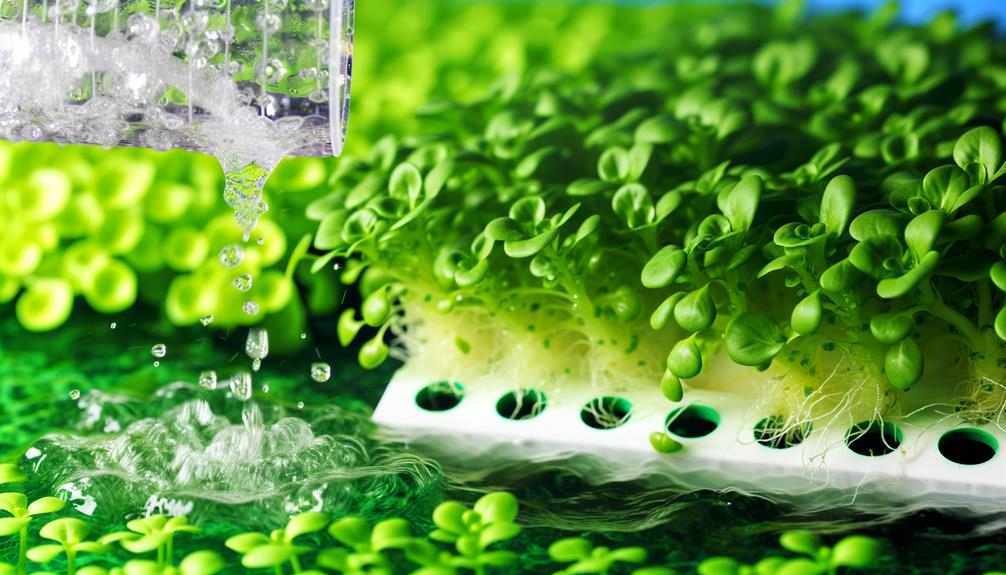
A hydroponic system’s success hinges on the precise formulation and management of its nutrient solution, which supplies essential minerals and elements directly to plant roots. Proper balance of macronutrients and micronutrients is crucial to ensuring optimal plant growth and preventing deficiencies. A wine bottle hydroponic planter offers a sustainable and creative way to cultivate plants in small spaces while maintaining control over nutrient delivery. By regularly monitoring pH levels and adjusting the nutrient composition, growers can maximize efficiency and promote healthy root development.
This solution must encompass a balanced array of macronutrients, including nitrogen (N), phosphorus (P), and potassium (K), as well as critical micronutrients like iron (Fe), manganese (Mn), and zinc (Zn).
The concentration of these nutrients must be meticulously calibrated to meet the specific growth stages and physiological needs of the plants.
Additionally, the ionic composition and electrical conductivity (EC) of the solution play pivotal roles in nutrient uptake efficiency.
Regular monitoring and adjustments are imperative to prevent nutrient deficiencies or toxicities, ensuring ideal plant health and maximizing yield potential in hydroponic cultivation systems.
Proper Ph Levels
Maintaining ideal pH levels is critical for nutrient uptake in hydroponic systems, as it directly influences the solubility of essential minerals.
Continuous monitoring of pH levels is crucial to guarantee they remain within the ideal range, typically 5.5 to 6.5, to prevent nutrient lockout.
Accurate adjustments, utilizing pH up or down solutions, should be made meticulously to maintain this balance and promote ideal plant health.
Importance of Ph Balance
Understanding the significant role of pH balance in hydroponic systems is fundamental for enhancing nutrient uptake and plant health. Proper pH levels guarantee that essential nutrients remain soluble and bioavailable. Deviations from the ideal pH range can lead to nutrient lockout, where plants cannot absorb critical minerals, resulting in deficiencies and stunted growth. Typically, the best pH range for hydroponic systems lies between 5.5 and 6.5.
| pH Level | Nutrient Availability | Plant Health Impact |
|---|---|---|
| 4.0-5.0 | Limited | Poor growth, deficiencies |
| 5.5-6.5 | Best | Healthy, vigorous growth |
| 7.0-8.0 | Decreased | Chlorosis, stunted growth |
| 8.5-9.0 | Very limited | Severe deficiencies |
| >9.0 | Negligible | Potential plant death |
Maintaining pH within this range is essential for maximizing hydroponic system efficacy.
Monitoring Ph Levels
Continuous and precise monitoring of pH levels is paramount for enhancing nutrient absorption and guaranteeing the health and productivity of hydroponic plants.
The ideal pH range for most hydroponic systems lies between 5.5 and 6.5, a range that facilitates the availability and uptake of essential nutrients such as nitrogen, phosphorus, and potassium. Deviations from this pH window can lead to nutrient lockout, where essential minerals become insoluble and inaccessible to plant roots.
Advanced pH meters and automated pH controllers are indispensable tools for maintaining this delicate balance. Regular calibration of pH monitoring equipment is also critical to guarantee accuracy.
Adjusting Ph Correctly
To effectively maintain the ideal pH range, growers must employ precise methods for adjusting pH levels, ensuring that nutrient availability is consistently maximized for hydroponic plants.
Accurate pH adjustment is critical as it directly influences ion solubility and nutrient uptake efficiency. Typically, the best pH range for hydroponic systems lies between 5.5 and 6.5.
Achieving this requires the use of pH up (alkaline) and pH down (acidic) solutions, calibrated pH meters, and buffering agents to stabilize fluctuations.
Regularly monitoring and adjusting pH levels mitigates nutrient lockout and promotes vigorous plant growth.
Additionally, incorporating automated pH control systems can enhance accuracy and reduce manual intervention, ensuring consistent and best growing conditions.
Adequate Lighting
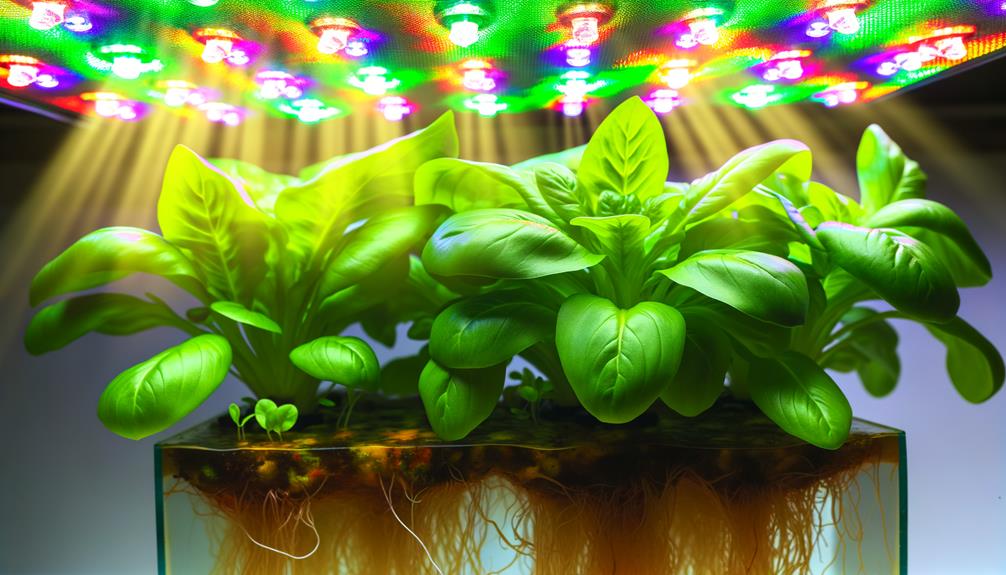
Proper lighting is essential for hydroponic systems, as it directly impacts photosynthesis and plant growth.
Key factors to evaluate include the light spectrum, which must encompass the necessary wavelengths for vegetative and flowering stages, as well as the duration and intensity of light exposure.
Understanding these parameters allows for the optimization of growth conditions, ensuring robust and healthy plant development.
Light Spectrum Requirements
Understanding the light spectrum requirements is essential for optimizing photosynthesis and ensuring the healthy growth of hydroponic plants. Different wavelengths of light influence various physiological processes. Blue light (400-500 nm) promotes vegetative growth, while red light (600-700 nm) is vital for flowering and fruiting. Green light (500-600 nm), often overlooked, penetrates deeper into the plant canopy enhancing overall growth. Ultraviolet (UV) light can stimulate secondary metabolite production, though excessive exposure may be harmful.
| Light Spectrum | Wavelength (nm) | Primary Effect |
|---|---|---|
| Blue | 400-500 | Vegetative growth |
| Green | 500-600 | Canopy penetration |
| Red | 600-700 | Flowering and fruiting |
| Far-Red | 700-800 | Stem elongation |
| UV | <400 | Secondary metabolites |
Maximizing the correct light spectrum is imperative for achieving robust hydroponic plant growth.
Duration and Intensity
While the light spectrum addresses the quality of light necessary for hydroponic plants, the duration and intensity of that light are equally critical factors in their successful growth and development.
Photoperiodism, the plant’s response to the length of day and night, dictates the specific duration of light exposure required, typically ranging from 12 to 18 hours daily.
Intensity, measured in micromoles per square meter per second (µmol/m²/s), must be refined to guarantee efficient photosynthesis. Insufficient light intensity can hinder growth, while excessive intensity may cause photoinhibition.
High-intensity discharge (HID) lights or light-emitting diodes (LEDs) are commonly employed to achieve peak intensity levels.
Balancing these parameters is essential to replicating natural conditions and promoting robust plant health in hydroponic systems.
Oxygen Supply
Adequate oxygen supply is essential for the root respiration process in hydroponic systems, directly affecting nutrient uptake and overall plant health. Roots immersed in nutrient solutions require dissolved oxygen to facilitate aerobic respiration, enabling efficient energy production and absorption of nutrients. Insufficient oxygen levels can lead to hypoxic conditions, causing root rot and stunted growth. The oxygenation of the nutrient solution can be achieved through various methods, such as air stones, oxygenating pumps, or the incorporation of hydrogen peroxide.
| Method | Mechanism | Benefits |
|---|---|---|
| Air Stones | Diffuse air into the solution | Enhances oxygen saturation |
| Oxygen Pumps | Circulate oxygen-rich water | Improves root respiration |
| Hydrogen Peroxide | Releases oxygen upon decomposition | Prevents anaerobic conditions |
Maintaining ideal dissolved oxygen levels is critical for robust hydroponic plant development.
Temperature Control
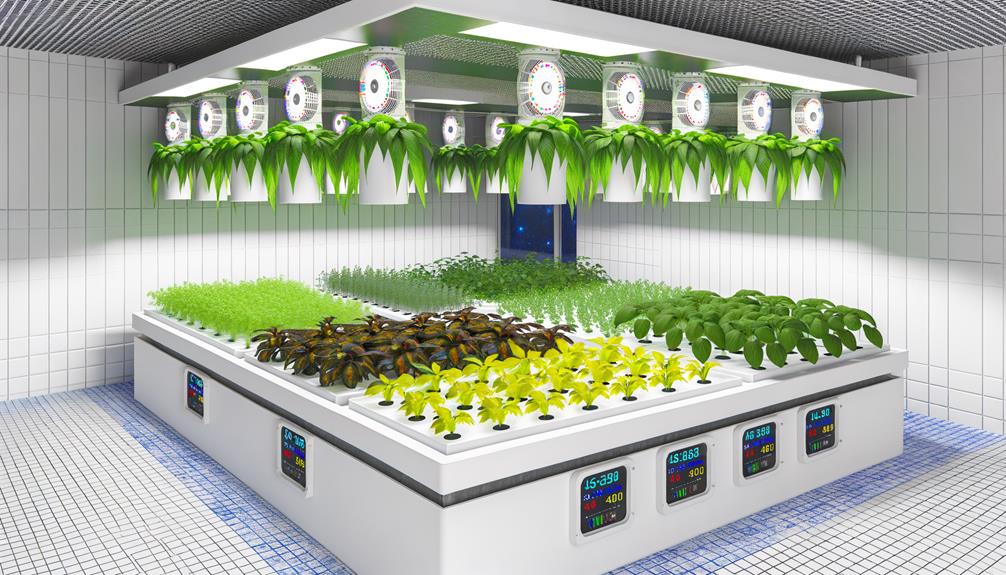
Maintaining ideal temperature ranges is fundamental for hydroponic systems to guarantee efficient nutrient uptake and prevent thermal stress on plant roots.
Best root zone temperatures generally range between 65-75°F (18-24°C). Deviations from this range can impair enzymatic activities and disrupt nutrient absorption, ultimately hampering plant growth. Elevated temperatures above 75°F can lead to oxygen depletion, exacerbating root hypoxia, while temperatures below 65°F can reduce metabolic rates and nutrient solubility.
Additionally, air temperatures should ideally be maintained between 70-80°F (21-27°C) to support photosynthesis and overall plant vigor.
Implementing temperature control mechanisms, such as water chillers, heaters, and environmental sensors, is essential. These technologies offer precise regulation, ensuring stable thermal conditions conducive to best hydroponic plant health and productivity.
Water Quality
Guaranteeing ideal water quality is paramount in hydroponic systems, as it considerably influences nutrient availability, pH balance, and overall plant health. The water’s electrical conductivity (EC) and total dissolved solids (TDS) must be closely monitored to guarantee optimal nutrient uptake. Additionally, pH levels should be maintained within a narrow range, typically between 5.5 and 6.5, to facilitate nutrient solubility.
| Parameter | Ideal Range |
|---|---|
| pH Level | 5.5 – 6.5 |
| Electrical Conductivity (EC) | 1.0 – 3.0 mS/cm |
| Total Dissolved Solids (TDS) | 500 – 2000 ppm |
| Dissolved Oxygen (DO) | 5 – 8 mg/L |
| Temperature | 65 – 75°F (18-24°C) |
Consistency in these parameters helps prevent nutrient lockout and promotes robust plant growth, guaranteeing the hydroponic system’s efficiency and productivity.
Support Structures
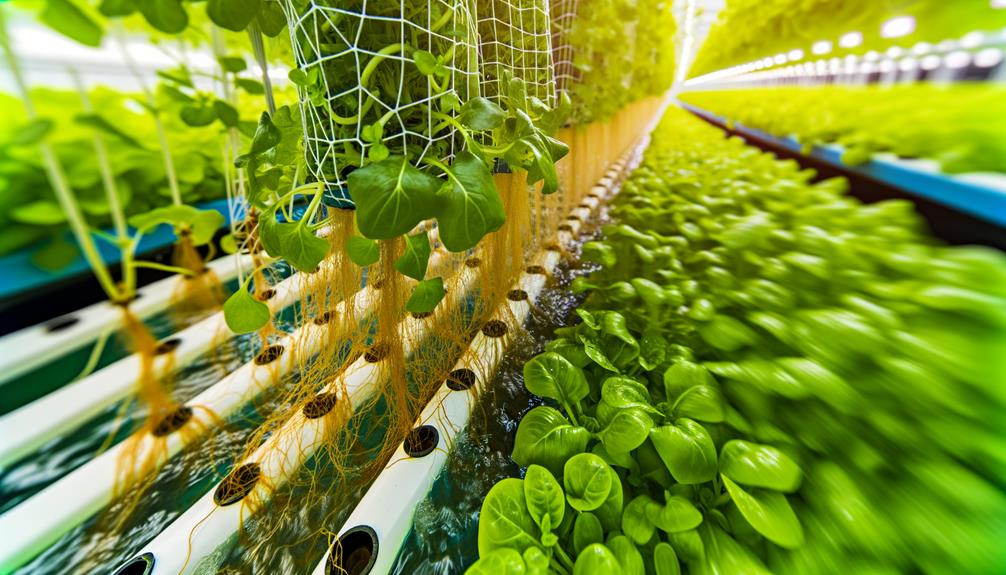
Appropriate support structures are essential in hydroponic systems to stabilize plants, prevent physical damage, and facilitate proper growth orientation. The absence of soil necessitates alternative means to secure plant roots and stems.
Effective support structures must meet several criteria:
- Robustness: The materials used should withstand hydroponic conditions, such as high humidity and water exposure, without degrading.
- Flexibility: Adjustable supports accommodate varying plant sizes and growth stages, providing continuous support.
- Non-toxicity: Materials must be inert, avoiding the leaching of harmful substances that could affect plant health.
Implementing these structures guarantees ideal nutrient uptake and growth efficiency. Utilizing scientifically-designed supports like trellises, stakes, and netting systems can greatly enhance the stability and productivity of hydroponic plants.
Conclusion
In summation, hydroponic cultivation thrives on a symphony of precise conditions.
The nutrient solution serves as the lifeblood, while proper pH levels maintain equilibrium.
Adequate lighting acts as the sun in this synthetic ecosystem, and an oxygen supply guarantees respiration.
Temperature control and water quality are the silent sentinels of health, and support structures provide the backbone.
Mastery of these elements transforms cultivation into an art, where each variable harmonizes to create a flourishing, soil-less garden.

